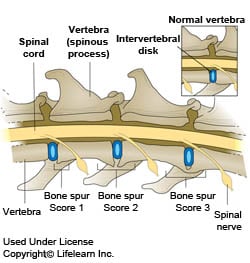Spondylosis
Spondylosis is a degenerative, non-inflammatory condition of the spinal column. Projected growth of bones known as bony spurs develop along the bottom, sides and upper aspects of the vertebrae of the spine. A bony spur can develop in a single spot on the spine however this is less common. The most common areas these lesions develop are the thoracic vertebrae especially at the junction between the rib cage and abdomen, in the lumber area of the spine and in the lumbosacral spine. Bony spurs can in some cases grow large enough that they appear to form a bridge between adjacent vertebral bones.
Canine Spondylosis
Symptoms:
Usually dogs with Spondylosis don’t have any symptoms, the growth of the bony spurs can be felt before any other changes can be noticed.
Bony spurs can occasionally restrict the movement of the spine so the dog may show signs of stiffness or restricted motion and the spine may appear to be less flexible. If a bony spur develops near the root of a nerve it can put pressure on the nerve which can cause lameness or pain, in this instance the dog may whine or cry out when touched on the affected area.
Causes:
Spondylosis is a chronic condition associated with ageing and often develops as a secondary problem related to degenerative disease of the intervertebral discs. Other causes may include problems growing new bone for example after a major trauma to the body. Even smaller traumas to the body for example repetitive pressure on the same joints or bones may bring on the condition.
Massage:
Increases circulation
Supports ares of overcompensation
Decreases referred pain from irritated nerves
Provided natural pain relief
Enables flexibility by decreasing tension

